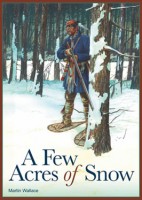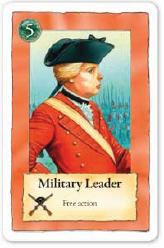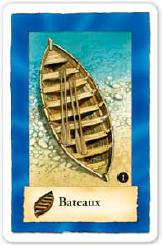
A Few Acres of Snow

A Few Acres of Snow involves a deck-building mechanism which may be familiar to those people who have played another certain award winning card game. Each player starts with a small set of cards. Cards come in two general types, location cards and empire cards. You can add an empire card to your discard pile simply by taking one as an action. Adding a location card is a little more involved. Each location card has a list of locations that it connects to and the transport type required to move to each of those locations. To take control of a neutral location you would have to play a location card with that neutral location on it, then a card that has the correct transport symbol, and then possibly a card with a settler symbol on it if required. You then place a cube in the location and add the location card to your discard pile.

Players take it in turns to perform two actions. There are a range of actions available, such as settling new locations, besieging locations, trading fur, launching Indian raids, and building fortifications. There are also cards that allow you to perform actions to manage your deck, such as getting rid of useless cards and drawing additional cards from your pile. You can also place cards in reserve so that you can use them at a later point in time.
The game ends if a player manages to capture his opponent’s capital city or he has managed to place all of his village or town pieces on the board. In the latter case points are calculated to see who wins.
User Reviews (5)
Add a Review for "A Few Acres of Snow"
You must be logged in to add a review.


The Designer of A Few Acres Of Snow isn’t shy in confessing that Dominion was his inspiration when creating the game. He saw the deckbuilding mechanic as a fascinating new idea, and resolved to use it to create a game with more depth and strategy. What he came up with is an interesting and clever 2-player conflict game which is novel and enjoyable but suffers from some flaws.
—
The background of the game is the Seven Years War between the British and the French – fighting over the North Eastern part of what we now call the United States and Canada. Both mighty empires had seen the potential in this vast new land, and were trying to exert their influence on it. Not easily done from across the Atlantic in the year 1760!
The game is played on a map board, which has an asymmetrical setup; the French are more established, the British richer and have slightly more Military. The board itself is attractive but suffers a little from style over functionality. Some rivers and roads on the map are not actually usable in play, which is confusing. Players will undoubtedly have moments where they find themselves debating if moves are legal or not, which suggests that the game perhaps wasn’t playtested across a wide enough audience of newbies.
The pieces are simple wooden discs and cubes which are uninspiring but perfectly functional. The art isn’t totally to my taste – colours are quite washed out in many pieces and there’s nothing to match the quality of the box cover – but it’s coherent and fits the theme. The rules are well laid out and overall clear and concise, although I did play my first ever game with some minor errors.
—
Each turn is simple in structure – you take two actions then draw up to five cards again. Each side is able to expand and develop their force on the board by playing combinations of cards from their hand. They can also purchase new cards from the supply using cash, and just like Dominion, when you draft a new card into your deck you can’t use it immediately – you need to wait until you have cycled your deck completely. This is meant to simulate the difficulties of supplying a conflict thousands of miles across the sea. Requests for more troops or cash could be very slow to arrive.
A key difference from Dominion is that at the end of your turn you do not discard any unused cards and draw a new hand – you simply ‘top up’ to the hand size of five. This causes real problems if you’re not careful with which cards you collect as your hand starts to fill up with junk that becomes very hard to shift. Expanding your empire is the main cause of this as you have to add that location’s card to your deck, and many of the villages you capture as stepping stones to other places have utterly worthless cards.
A major problem for new players is not understanding this and stalling in the middle of the game, with a poor deck and few ways to solve the issue. There is a ‘Chapel’ style card which allows you to thin your deck, but each player only has one of them and again, you need to buy it and wait for it to cycle into your hand before you can use it.
The other new mechanic which helps with this is the “Reserve” – an area to store up to 5 cards which you may need in the future, although you do have to pay to get them back again.
Another issue for new players is the seemingly huge list of actions you can take. The Player Aid offers perhaps 25 different options with key items like Expansion, Fortification, Raiding, Development, Trading Furs, Earning Gold, Besieging forts, Buying Cards and so on split into several minor choices – all of which can be overwhelming – particularly if you don’t know how the game pans out. After playing for a short time you realise that only perhaps 3 or 4 options are ever available to you at any time, based on your hand, and it becomes easier to manage.
—
A Few Acres Of Snow is a game which rewards multiple plays between the same two players, swapping sides frequently to work out the various tactics and strategies that each nation can use.
There is a steep learning curve which will put off casual gamers, and it’s not without its quirks. I also have a fear that with fixed starting cards, positions and decks, replayability will not be as high as you might like.
Even with all those criticisms, this is still a strong game which is very thematic and requires a great deal of thought and planning. I’d recommend it but only if you like good strategic depth, often play two player games, and your opponent is happy to spend the first game or two just working out the system. If you’re after instant gratification then look elsewhere.
Every kid growing up in Canada learns about the Seven Years’ War (or as the Yanks call it, the French and Indian War), which took place between 1754 and 1763 and involved the British colonies and New France.
Many of us even get to visit the Plains of Abraham in Quebec City where the French under Montcalm and the British under Wolfe waged a bloody battle in 1759; consequences of which reverberate through the Canadian and Quebecois psyche today.
I understand that history, never mind Canadian history, can be dull for some. Personally, I love it so much I majored in it, but had I played A Few Acres of Snow as an undergrad, a few dimensions of the Seven Years’ War would have been indelibly imprinted on me.
The first is the map/game board. It’s not lavishly illustrated but it need not be. It’s functional and aesthetically pleasing and not crowded. The extant British territory and French Canadian areas of control are clearly marked allowing you to consider expansion.
And expand your territory you must.
The French are as you would expect in this battle, under-resourced compared to the British. The red coats start out with more money and more territory. But the French need not be so disadvantaged. For example, the coureur de bois and traders allow the French player to trade in beaver pelts for cash and the money comes in handy.
But let’s get to how one expands territory. A Few Acres uses a fascinating, and at first hard to get the hang of, method of settling villages and towns.
The best way to explain is to offer an example. Let’s say you want to establish a French village in Oswego. First, check if you have a card that connects you to that town. Aha! Montreal will get us there and the French start the game with Montreal under its command. You’ll see Oswego listed on the card as a connected town and an icon will be next to that list illustrating how Montreal makes the connection. In this case, we need a bateaux (ie a large wooden boat). Find a card in your hand that bears the icon of the bateaux in the bottom “parchment” area of the card. Play both cards and you can place one of your blue cubes (that is, a village) in Oswego. It’s now yours and you’re a bit closer to the British front. Once you gain a town, look for the card in your location deck, in this case Oswego, and add it to your discard pile.
So why expand and settle?
First, one gains points assuming a point box is next to your conquered town. These points will be tallied up at the end of the game to declare a winner. Second, is that you can set up a front and fortify it (you can purchase a fortify card that boosts the defences of a settlement) and keep your enemy from successfully laying siege to your settlements. You can also prevent raids.
Raids allow your opponents to swipe a village cube if you can’t defend it. Your cube enters their supply and will count as points at the end of the game. You’ve also just lost a town…
You also want to expand because the location cards of settled towns carry effects such as connections to other towns and resources and/or modes of travel in the parchment area.
How one gains cards and uses them is a delightful mechanic. You start with pre-determined deck and hand of five cards. You may take up to two actions per turn. Once your discard deck is depleted, you shuffle it and it becomes your new draw deck. So, those location cards you picked up, or Empire cards you drafted, or neutral cards you scooped, become part of your draw deck.
In short, it mimics how slowly resources made their way to the generals but things improve as you build up your resources. Since it takes time to get the cards you need, you won’t be laying siege to Boston in the first two turns. This mechanic is used in variety of games, including my beloved Marvel Legendary.
There’s not too much more to the gameplay other than going through the variety of actions you can take on your turn. Better you check out the game instructions online than have me go over those here.
Pros:
Immersive theme
Decent components and good artwork without being over-done
Fun card drafting mechanic
Variety of actions
Historically accurate starting imbalance between French and British
Cons:
Niche game that may not float everyone’s bateaux
Can be fairly long (admit, not a con for me)
Pre-determined starting cards means the game always starts with the same positions in play (again, not a big deal for me)
Verdict:
I love Canadian history and I feel this game brings the Seven Years’ War to life. I enjoy the richness the mechanics offer and have to admit, I favour playing the French side. So much gameplay over, what Voltaire said, was “a few acres of snow”.
I am continually intrigued by this game. The 7 Years War is a fantastic topic for a game, and one I have not seen before. I especially enjoy it, because the whole map is of my home area. It really seems to represents the unbalanced forces of the British and the French in the war as well. The English have far greater ability to generate money (and then buy troops) but the French have a better ability to spread into new areas of the map. This unbalance makes for difficult strategies and challenging choices. The goal of the game is to achieve overwhelming force in the New World, by either eliminating the opponent’s capital or by having a vast majority of settlements on the board. All of this action is done with a small hand of 5 cards. In order to settle a location, you need at least 2 cards (which both have to have the right symbols on them to work) in your hand at the same time. To attack your opponent’s settlement, you need at least 3 cards at the same time, and then you need to put all your effort into keeping up the siege. The end result is an economy which is extremely tight. This can be both challenging and frustrating at the same time. The real challenge is managing your hand to try and achieve your goals. Without paying special attention to the cards in your hand, and trashing the right cards at the right time, you wind up with the wrong cards all the time. A Few Acres of Snow has taken me a long time to understand, and much longer to really appreciate. If you have not tried this yet, you owe it to yourself to give it a few tries. It may frustrate you at first, but give it a real chance.
After the first two plays of this game, I have to say that the 60-90 minutes per game listed on the box is not true unless you are playing with a very fast player. It took us about 3 hours total to finish one game. That being said, A few acres of snow is an amazing game, and the use of the Dominion mechanic to manipulate pieces on a board game is brilliant. This game is relatively easy to teach if one player knows the game. We picked it up and were rolling with it with minor glances at the rules. I can’t wait to play this game more and dig into deeper strategies
this game and mage knight game is at the moment my fav…. in my opinion card building like dominion can only take you so far with out theme and physical maps that is where this game come in deck building with theme and actual game play….if you like dominion but feel like the game is missing something…. try this game